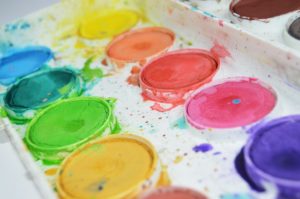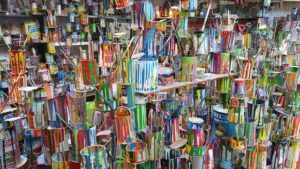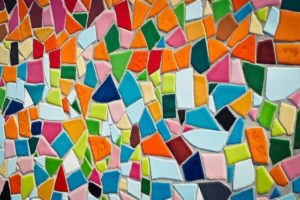Anyone who knows me even a little bit knows my favorite color is purple. If there are 100 items on a table, my eye will quickly spot the purple one in the mix. Color is powerful like that. This is why color tools for web design are so important.
See, color can manipulate the way we think and feel and hold different meanings for different cultures. No wonder it’s such an essential foundational aspect for any website design.
If you aren’t a graphic designer or artist, choosing the right colors might seem like a daunting task. You might be able to tell whether or not a color combo looks good when you see it. However, successfully creating a great combo requires a lot of experience. Thankfully, we live in a digital age where you can find just about anything online. That includes color tools for web design.
There are lots of color tools for web design available, and many of them have similar functionality. These are my five favorite online color tools that I use on all of my web design projects.
Extracting Colors from an Image
 The Extract Theme option on Adobe Color is my go-to when I have no specific colors to start with but do have an image for inspiration. All you have to do is upload the image and let Adobe Color perform its magic.
The Extract Theme option on Adobe Color is my go-to when I have no specific colors to start with but do have an image for inspiration. All you have to do is upload the image and let Adobe Color perform its magic.
Let’s use a nice beach scene, complete with blue water, green trees, and light brown sand as an example. Once the image is uploaded, we get five automated color palettes to choose from: colorful, bright, muted, deep, and dark.
Each of these palettes has five colors which are pulled from specific points in the image. You can move the spots around the image to choose a different color if you prefer.
The hex codes, which are used to specify the color in web design, are displayed below each color swatch and will be copied to your clipboard if you click on them. If you have a free Adobe account, you can save your palette and get access to different types of color codes and additional functions.
Finding Complementary Colors and Inspiration
 Whether you are starting from scratch or have a couple of colors but need to find more to form a broader palette, Coolors has a fun generator to help. When you land on the Generate page, it displays a random palette of five colors that work well together.
Whether you are starting from scratch or have a couple of colors but need to find more to form a broader palette, Coolors has a fun generator to help. When you land on the Generate page, it displays a random palette of five colors that work well together.
To see another palette, simply hit the space bar and voilà! Five new colors magically appear. Each of the colors is identified by its hex code and its name.
Hover on a specific color and you get some useful options, like choosing a different shade of that color or marking the color as a favorite. If you find a color you like but want to see what other colors might complement it, you can lock in that color. Hit the space bar again, and you’ll get a new group of colors including any in which you locked.
Another really neat option can be found by hovering between two colors. Click on the plus sign to add a blend of the two colors. When you are happy with the color palette, you can export it in a variety of ways for sharing and using directly in your project. A word of caution with this site: it’s very easy to spend hours hitting the space bar and playing around!
Expanding Your Color Palette
 Now that you have your main colors selected, it’s time to start using them. Often these main selections will be all that I need for a site, but what if I need a variation of a color?
Now that you have your main colors selected, it’s time to start using them. Often these main selections will be all that I need for a site, but what if I need a variation of a color?
For example, if all the colors are pretty dark and bold, I may want to use one for just a hint of a background color. Enter Tint & Shade Generator!
This site lets you enter in your base colors and displays 10 tints through to white and 10 shades through to black for each color. As with the other tools, the hex code is shown for each color swatch.
While you can get similar information from the previous color tools mentioned, the Tints & Shades Generator is great for having all of the options readily available at the same time.
Color Conversion and So Much More
 If I have been given a palette to work with and the color codes provided don’t include hex format, I hop on over to Colorhexa. You can look up a color by any format type you can think of (eg RGB, HSL, CMYK), as well as formats you didn’t even know existed.
If I have been given a palette to work with and the color codes provided don’t include hex format, I hop on over to Colorhexa. You can look up a color by any format type you can think of (eg RGB, HSL, CMYK), as well as formats you didn’t even know existed.
Each color has its own page that lists out how the color is represented in 14 formats. So, you can grab whichever version suits your needs. But as they say on late night TV, “Wait! There’s more!”
There is a wealth of information about your chosen color, including suggested color schemes, alternative options, and a color blindness simulator. If you like one of the new colors you see, you can click on it to go to its information page, or hover over it to display the hex and RGB codes. This is another color tool for website design that I could spend hours on, if I’m not careful.
Check Contrast
 No list about color tools for web design would be complete without addressing accessibility. Most of the tools I’ve mentioned have some accessibility options within them. But there is an extra tool that I find really helpful: the Accessible Color Palette Builder.
No list about color tools for web design would be complete without addressing accessibility. Most of the tools I’ve mentioned have some accessibility options within them. But there is an extra tool that I find really helpful: the Accessible Color Palette Builder.
This site lets you enter up to six hex codes, and it will create a visual table of accessible color combinations. This table indicates which colors can be paired together as text and background, based on a contrast ratio of 4.5:1, and shows what the combination would look like.
Please note, the options provided should be considered a guideline, not hard and fast rules. Some components or larger text might be okay to implement combinations with less contrast. On the flip side, some of the passing combinations might be a poor choice for specific font styles and sizes.
Conclusion
I hope you enjoy playing around with these color tools and find some fantastic palettes to work with. Bonus tip: you can use these tools for inspiration for anything that uses color, not just websites. Find colors to decorate your home with or choose pencil crayons to color a mandala.
If you’d rather leave color selection and design to the professionals, get in touch with us at WebDevStudios. We love color and would be happy to help make your brand shine online!
Want more inspiration? Check out this Spotify playlist. These tunes are sure to stimulate your palette.
Comments